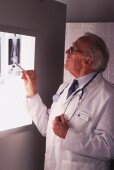
MONDAY, April 15 (HealthDay News) — Including photos of patients’ faces with their X-ray images led to a fivefold decrease in patient-identification errors, according to a new study.
Researchers asked 10 radiologists to look at 20 pairs of X-ray images, with and without patient photos. There were two to four mismatched pairs in each set of 20 pairs. Without patient photos, the error detection rate was 13 percent; the rate improved to 64 percent when photos were included.
Some of the radiologists ignored the photos, however, because they thought the objective of the experiment was to determine if they would be distracted by photos.
The researchers then conducted another test with five radiologists who were told to use the photos. The error detection rate rose to 94 percent, according to the study, which is scheduled for Monday presentation at the annual meeting of the American Roentgen Ray Society in Washington, D.C.
“X-rays can look alike, and if one patient’s images are confused with another before the radiologist sees them, it can be difficult for the radiologist to determine there is a mismatch,” study author Dr. Srini Tridandapani, an assistant professor at the Emory University School of Medicine in Atlanta, said in a society news release.
“I estimate that about one out of 10,000 examinations have wrong-patient errors,” Tridandapani said. “It occurred to me that we should be adding a photograph to every medical-imaging study as a means to correct this problem after I received a phone call, and a picture of the caller appeared on my phone. The picture immediately identified for me who the caller was.”
More information
The U.S. Food and Drug Administration has more about X-rays.

